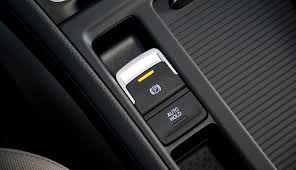
Design and principle of operation of the electromechanical parking brake (EPB)
Content
An important part of any car is the parking brake, which locks the car in place during parking and prevents it from unintentionally rolling back or forward. Modern cars are increasingly equipped with an electromechanical type of parking brake, in which electronics replace the usual "handbrake". The abbreviation for Electromechanical Parking Brake “EPB” stands for Electromechanical Parking Brake. Let's take a look at the main functions of the EPB and how it differs from the classic parking brake. Let's analyze the elements of the device and the principle of its operation.
EPB functions
The main functions of the EPB are:
- keeping the vehicle in place when parked;
- emergency braking in case of failure of the service brake system;
- preventing the car from rolling back when starting on an uphill.
EPB device
The electromechanical handbrake is installed on the rear wheels of the vehicle. Structurally, it consists of the following elements:
- brake mechanism;
- drive unit;
- electronic control system.
The braking mechanism is represented by standard car disc brakes. The design changes were made only to the working cylinders. The parking brake actuator is installed on the brake caliper.
The parking brake electric drive consists of the following parts, located in one housing:
- electric motor;
- Belting;
- planetary reductor;
- screw drive.
The electric motor drives the planetary gearbox by means of a belt drive. The latter, by reducing the noise level and the weight of the drive, affects the movement of the screw drive. The drive, in turn, is responsible for the translational movement of the brake piston.
The electronic control unit consists of:
- input sensors;
- the control unit;
- executive mechanisms.
Input signals come to the control unit from at least three elements: from the handbrake button (located on the center console of the car), from the slope sensor (integrated into the control unit itself) and from the clutch pedal sensor (located on the clutch actuator), which detects position and speed of release of the clutch pedal.
The control unit acts on the actuators via the sensor signals (such as the drive motor, for example). Thus, the control unit interacts directly with the engine management and directional stability systems.
How EPB works
The principle of operation of the electromechanical parking brake is cyclical: it turns on and off.
EPB is activated using a button on the center tunnel in the passenger compartment. The electric motor, by means of a gearbox and a screw drive, draws the brake pads to the brake disc. In this case, the latter is rigidly fixed.
And the parking brake is turned off during the start of the car. This action takes place automatically. Also, the electronic handbrake can be turned off by pressing the button while the brake pedal is already pressed.
In the process of disengaging the EPB, the control unit analyzes such parameters as the grade of the slope, the position of the accelerator pedal, the position and speed of releasing the clutch pedal. This makes it possible to turn off the EPB in a timely manner, including a time-delayed shutdown. This prevents the vehicle from rolling backwards when starting on an incline.
Most cars equipped with EPBs have an Auto Hold button next to the handbrake button. This is very convenient for vehicles with automatic transmission. This function is especially relevant in urban traffic jams with frequent stops and starts. When the driver presses the Auto Hold button, there is no need to hold down the brake pedal after stopping the vehicle.
When stationary for a long time, the EPB turns on automatically. The electric parking handbrake will also turn on automatically if the driver switches off the ignition, opens a door or unfastens the seat belt.
Advantages and Disadvantages of EPB Compared to Classic Parking Brake
For clarity, the pros and cons of the EPB in comparison with the classic handbrake are presented in the form of a table:
| EPB benefits | Disadvantages of EPB |
|---|---|
| 1. Compact button instead of bulky lever | 1. Mechanical parking brake allows you to adjust the braking force, which is not available for EPB |
| 2. During the operation of the EPB, there is no need to adjust it | 2. With a completely discharged battery, it is impossible to “remove from the handbrake” |
| 3. Automatic shutdown of EPB when starting the car | 3. Higher cost |
| 4. No rollback of the car on the rise |
Features of maintenance and operation of vehicles with EPB
To check the performance of the EPB, the car must be installed on a brake tester and braking with the parking brake. In this case, the check must be carried out regularly.
The brake pads can only be replaced when the parking brake is released. The replacement process takes place using diagnostic equipment. The pads are automatically set to the desired position, which is fixed in the memory of the control unit.
Do not leave the car on the parking brake for a long time. When parked for a long time, the battery can be discharged and the car cannot be removed from the parking brake.
Before carrying out technical work, it is necessary to switch the vehicle electronics to the service mode. Otherwise, the electric handbrake may automatically turn on during service or repair of the vehicle. This, in turn, can damage the vehicle.
Conclusion
The electromechanical parking brake relieves the driver of the problem of forgetting to remove the car from the parking brake. Thanks to EPB, this process takes place automatically when the vehicle starts moving. In addition, it makes it easier to start the car uphill and greatly simplifies the life of drivers in traffic jams.

